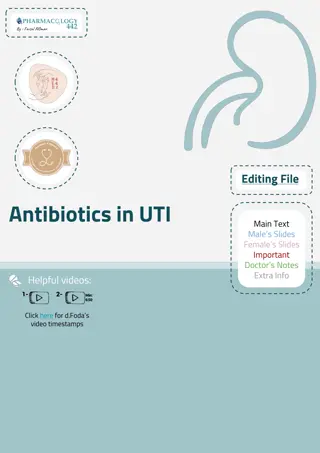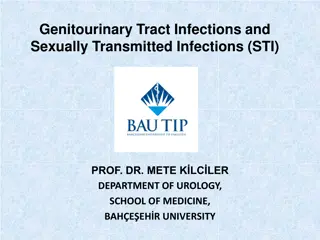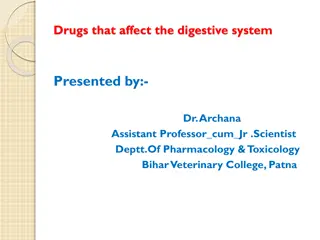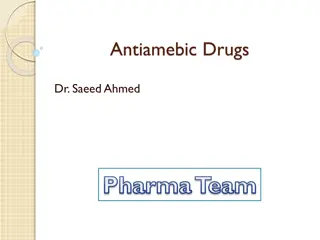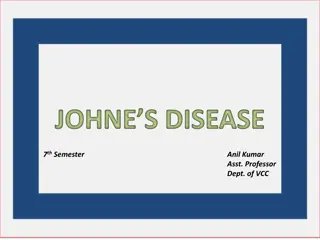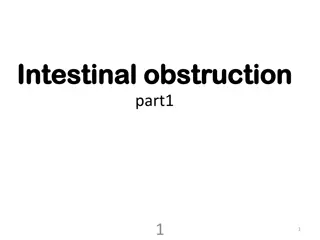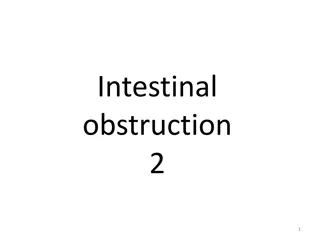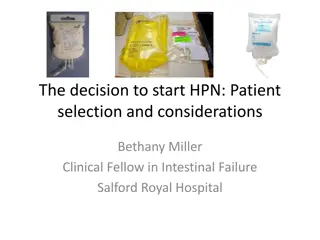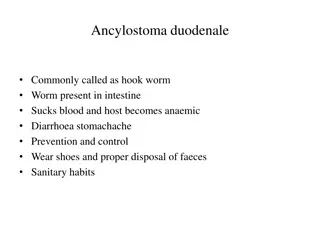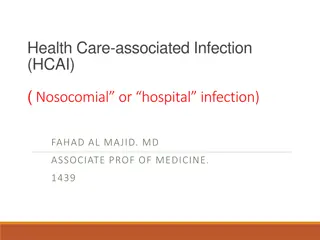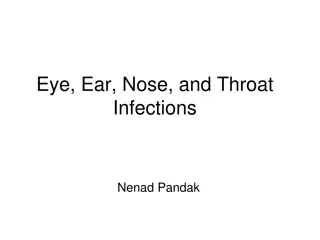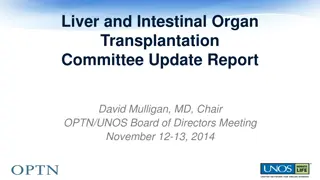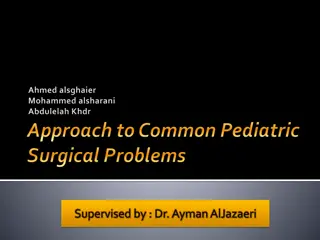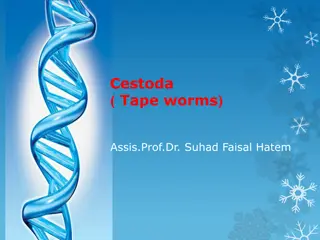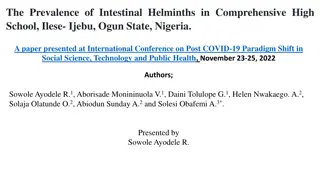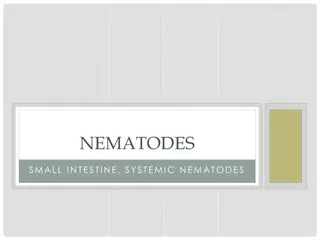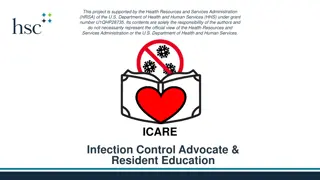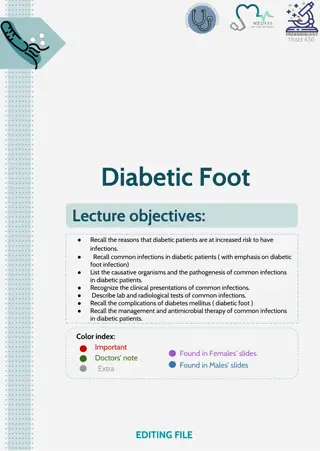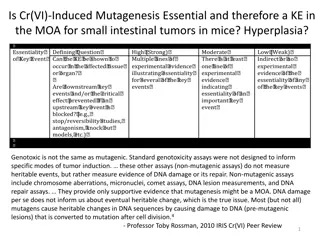Understanding Anaemia and Infections in Relation to Health
Anaemia can result from various causes such as blood loss, increased destruction of red blood cells, and impaired production, often linked to infections and chronic diseases. Parasites, bacteria, and viruses play a role in the progression of anaemia, affecting the body's ability to produce and utili
3 views • 10 slides
Understanding Nontuberculous Mycobacteria Infections in Cystic Fibrosis
Nontuberculous mycobacteria (NTM) infections present a significant challenge in individuals with cystic fibrosis (CF). These infections are caused by over 200 species of atypical mycobacteria found in various environments. The CF-ID Clinic plays a crucial role in managing patients with multi-drug re
2 views • 25 slides
Estimation of Serious Mycoses Burden in Indonesia
This study estimates the burden of serious fungal infections in Indonesia, a country with rich biodiversity and limited medical mycology facilities. The data indicates a high prevalence of opportunistic infections in AIDS patients and TB cases, with Candidiasis and Cryptococcosis being significant c
2 views • 29 slides
Understanding Urinary Tract Infections (UTIs) and Antibiotics: A Comprehensive Overview
Urinary Tract Infections (UTIs) are a common issue, more prevalent in women, with causes ranging from poor hygiene to underlying health conditions. The content delves into the classification of UTIs, their main causes, and bacteria responsible for infections. It also covers the complications of UTIs
0 views • 12 slides
Anaerobic Bacterial Infections: Overview and Clinical Implications
Anaerobic bacterial infections are caused by bacteria that do not require oxygen for growth, posing challenges in diagnosis and treatment. This article delves into the types of anaerobic bacteria, their role in human infections, and common clinical presentations such as abscess formation. Gram-negat
2 views • 24 slides
Overview of Genitourinary Tract Infections and STIs by Prof. Dr. Mete Kılcıler
Genitourinary Tract Infections and Sexually Transmitted Infections (STIs) are common conditions affecting both men and women. This article, presented by Prof. Dr. Mete Kılcıler from the Department of Urology at Bahçeşehir University School of Medicine, delves into the various aspects of UTIs, in
2 views • 47 slides
Understanding Fungi Diversity and Infections in Microbiology
Explore the world of fungi and fungal infections in this foundation block of microbiology. Learn about medically important yeasts, mold fungi, major fungal diseases, antifungal agents, and infection acquisition methods. Dive into hypersensitivity reactions, mycotoxicoses, and various types of fungal
1 views • 19 slides
Drugs Affecting the Digestive System and Their Functions
This presentation by Dr. Archana covers various drugs that impact the digestive system, such as antacids, intestinal astringents, antiemetics, and more. It explores the functions of these drugs and their roles in treating stomach-related issues like gastritis and peptic ulcers. The chapter discusses
0 views • 20 slides
Understanding Virus-Cell Interactions and Infections
Viral infections exhibit diverse cellular tropism based on receptor interactions, impacting cell function through modulation and potential host defense responses. Infections can lead to various outcomes, from cell death to persistent or latent states, with nuanced effects on cellular behavior. Diffe
0 views • 8 slides
Understanding Antiamebic Drugs: A Guide to Managing Protozoal Infections
Protozoal infections, such as amebiasis, are a significant concern globally. In underdeveloped regions and beyond, these infections pose challenges due to inadequate sanitation and hygiene practices. Antiamebic drugs are essential for treating conditions like amebiasis, caused by Entamoeba histolyti
0 views • 40 slides
Understanding Johne's Disease in Ruminants: Causes, Transmission, and Clinical Findings
Johne's Disease, caused by Mycobacterium paratuberculosis, is a chronic bacterial infection affecting the lower intestinal tract of ruminants. It is characterized by chronic diarrhea and emaciation, mainly seen in mature animals. The mode of transmission includes contaminated food/water, intrauterin
0 views • 12 slides
Understanding Intestinal Obstruction: Causes, Classification, and Pathophysiology
Intestinal obstruction can be classified into dynamic and adynamic types, with various causes such as intraluminal faecal impaction, malignancy, and hernia. The pathophysiology involves changes in bowel peristalsis and dilation, leading to potential strangulation and ischemia. Morbidity and mortalit
9 views • 40 slides
Radiological Features and Clinical Presentations of Intestinal Obstruction
Intestinal obstruction can manifest with various clinical features such as sudden severe pain, tenderness, fever, and more. Imaging plays a crucial role in diagnosing obstruction, with X-rays showing characteristic findings in the small bowel and colon. Different types of obstructions like strangula
0 views • 43 slides
Understanding Anthelmintics: Drug Therapy for Parasitic Worm Infections in Veterinary Medicine
Anthelmintics are essential drugs to combat parasitic worm infections in animals. They work either by killing (vermicide) or expelling (vermifuge) the worms, reducing worm burdens and controlling infections. This comprehensive overview covers different aspects of anthelmintics, including their prope
2 views • 34 slides
Understanding the Treatment of Respiratory Tract Infections: Antibiotics and Management
This lecture covers the classification of respiratory tract infections and the antibiotics commonly used to treat them. It highlights the types of infections caused by viruses and bacteria, along with their respective treatments. The mechanism of action and pharmacokinetics of antibiotics, such as p
0 views • 7 slides
Organoid Models for Neuroendocrine Cell Growth and Tumorigenesis
Research presented at the ENETS 2020 virtual meeting discussed the generation of organoids from lung, intestinal, and pancreatic neuroendocrine neoplasms (NENs) to study normal neuroendocrine cells and their transformation to NENs. The success rate in generating organoids was higher for lung NENs co
0 views • 20 slides
Advanced Herbal Approaches for Gastro-Intestinal Lyme Disease Treatment
Unveil the symptoms, stealth pathogenic gut infections, differentiation from typical GI diseases, causes of GI disorders, and post-natal Qi tonification in addressing Gastrointestinal Lyme Disease using advanced herbal studies. Learn to differentiate infectious GI diseases, identify potential causes
0 views • 38 slides
Understanding Human Parasites: Laboratory Testing, Neglected Tropical Diseases, and More
Explore the world of human parasites through laboratory testing for intestinal, blood, and tissue parasites. Learn about neglected tropical diseases, common parasitic disease exposures, Texas notifiable conditions, and additional parasites to be aware of. Traditional parasitology techniques involvin
0 views • 19 slides
Parenteral Nutrition in Intestinal Failure Related to Advanced Abdominal Cancer
Discussion on parenteral nutrition in patients with intestinal failure secondary to advanced abdominal cancer, including considerations for patient selection, Christie referral pathway, and practicalities of home parenteral nutrition. The background highlights the increasing commonality of home pare
0 views • 40 slides
Common Human Intestinal Parasites and Their Prevention
Ancylostoma duodenale, Wuchereria bancrofti, Dracunculus medinensis, and Enterobius vermicularis are common human parasites causing various diseases. From hookworms to pinworms, these parasites can lead to anemia, filariasis, elephantiasis, and inflammation. Proper sanitation and hygiene practices,
0 views • 9 slides
Understanding Diarrhea: Causes, Symptoms, and Pathophysiology
Diarrhea is a common symptom that can be caused by various factors such as viral, bacterial, parasitic infections, dietary changes, drugs, systemic diseases, and intestinal obstructions. It can lead to dehydration and other serious complications if not treated promptly. The pathophysiology of diarrh
0 views • 15 slides
Understanding Health Care-associated Infections (HCAI) in Hospital Settings
Health care-associated infections (HCAI), also known as nosocomial or hospital infections, are infections that occur in patients during their hospital stay or after discharge. These infections can result from various sources, including colonization by microorganisms and exposure to contaminated envi
0 views • 48 slides
Overview of Gram-Negative Enteric Bacilli
Gram-negative bacilli are a diverse group of bacteria, including enteric and non-enteric bacilli. Common characteristics include being aerobic or facultative anaerobes, fermenting glucose, and being part of the normal flora of the human and animal gastrointestinal tract. Escherichia coli (E. coli) i
0 views • 27 slides
Overview of Eye, Ear, Nose, and Throat Infections by Nenad Pandak
In this comprehensive guide by Nenad Pandak, various aspects of eye, ear, nose, and throat infections are discussed. The content covers infections such as conjunctivitis, keratitis, pharyngitis, otitis media, and sinusitis. It also delves into causes, clinical presentations, and diagnosis of these i
0 views • 68 slides
Understanding Respiratory Tract Infections: Causes and Prevention
Respiratory tract infections are commonly caused by viruses, bacteria, rickettsia, and fungi, leading to various health issues. These infections can be transmitted through droplets, droplet nuclei, and dust, emphasizing the importance of maintaining respiratory health through specific and non-specif
0 views • 34 slides
Understanding Giant Intestinal Roundworms: Ascaris lumbricoides
Ascaris lumbricoides, also known as the Giant Intestinal Roundworm, is a common parasitic nematode infecting the human intestines, especially prevalent in underdeveloped regions with poor sanitation. Found in the small intestines, this worm can cause significant health issues. Learn about its morpho
0 views • 31 slides
Overview of Small Intestine Histology and Function
The small intestine is a key organ in the digestive system responsible for the digestion and absorption of nutrients. It is divided into the duodenum, jejunum, and ileum, each with specific functions and structures like plicae circulares, villi, microvilli, and crypts of Lieberkühn. The intestinal
0 views • 14 slides
Intestinal Helminths: Classification, Nematodes, and Common Infections
Intestinal helminths, including nematodes, are classified into unicellular and multicellular parasites. Nematodes are elongated worms found in the human body, causing common infections such as Enterobius vermicularis. The pathology of Enterobius infections often presents with pruritus ani. Learn abo
0 views • 53 slides
National Deworming Day 10 August 2018 - Importance, Benefits, and Process
National Deworming Day on 10 August 2018 aims to deworm all children using albendazole chewable tablets to combat intestinal worms, which can cause anemia and other health issues. In cases where children could not be dewormed on the designated day, a mop-up day on 17 August is scheduled. Deworming h
0 views • 5 slides
Understanding Viral Infections of the Respiratory System
Respiratory viral infections are common and primarily caused by viruses, leading to morbidity and time off work. They can range from mild upper respiratory tract infections to severe lower respiratory tract infections like pneumonia. Various viruses like influenza, parainfluenza, respiratory syncyti
0 views • 23 slides
Liver and Intestinal Organ Transplantation Committee Update Report
Update report on liver and intestinal organ transplantation committee activities, including developing materials to educate liver regional review board members, strategic planning, addressing operational guidelines affecting the review process, and implementing a National Liver Review Board followin
0 views • 11 slides
Pediatric Intestinal Obstruction: Causes, Symptoms, and Management
Pediatric intestinal obstruction in newborns and older children can result from various conditions such as foregut obstruction, midgut obstruction, and hindgut obstruction. Common causes include esophageal atresia, pyloric stenosis, and Hirschsprung disease. Diagnosis involves clinical evaluation, i
0 views • 81 slides
Understanding Tapeworm Infections and Their Impact on Human Health
Tapeworms, particularly Taenia solium and Taenia saginata, are medically important cestodes that cause parasitic infections in humans. These flat, segmented worms attach to the intestinal wall and rely on intermediate hosts like cows and pigs to complete their life cycle. Infestations can lead to di
0 views • 8 slides
Prevalence of Intestinal Helminths in Comprehensive High School, Ilese-Ijebu, Ogun State, Nigeria
Infestation by intestinal helminths poses a significant public health issue, impacting school-age children with chronic anaemia, growth stunting, malnutrition, fatigue, and cognitive impairments. The study aims to investigate the prevalence of intestinal helminths in a Comprehensive High School in I
0 views • 14 slides
Overview of Intestinal Nematodes: Ascaris lumbricoides and Strongyloides stercoralis
Intestinal nematodes, including Ascaris lumbricoides and Strongyloides stercoralis, are common parasitic infections affecting the small intestine. Ascaris is a roundworm with a global distribution, transmitted via fecal-oral route or flies, while Strongyloides is a threadworm primarily found in trop
0 views • 24 slides
Understanding Common Infections in Nursing Home Residents
Explore the causes, types, and impact of infections in nursing home residents while learning how to prevent and control infections. Discover common infections, factors contributing to infections, and resident rights in infection control practices.
0 views • 23 slides
Understanding Diabetic Foot Infections and Associated Risks
Diabetic patients are prone to infections, significantly impacting morbidity and mortality rates. Increased infection risk is due to both host-related and organism-related factors. Common infections in diabetic patients include skin and soft tissue infections, diabetic foot infections, respiratory t
0 views • 14 slides
Preventing Catheter-Associated Urinary Tract Infections
This presentation covers the prevention of catheter-associated urinary tract infections (CAUTIs) in healthcare settings. It highlights the significance of urinary tract infections, risk factors, preventive measures, and common microbiology involved. Key topics include the importance of urine collect
0 views • 34 slides
Essentiality of Cr(VI)-Induced Mutagenesis in Small Intestinal Tumor Development in Mice
Cr(VI)-induced mutagenesis is a key event in the mode of action for small intestinal tumors in mice, with the question of whether it is an essential step in tumor development. The interaction of cellular components with Cr leads to cell proliferation, hyperplasia, and ultimately mutagenesis. Differe
0 views • 4 slides
Managing Catheter-Related Bloodstream Infections in Vascular Access
Reduce and prevent catheter-related bloodstream infections in vascular access by addressing extraluminal infection sources and implementing strategies outlined in national drivers such as the NHS Long Term Plan and the Antimicrobial Resistance Action Plan. Recognize the importance of tackling antimi
0 views • 25 slides



